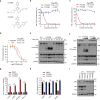Transcriptional repression of estrogen receptor alpha by YAP reveals the Hippo pathway as therapeutic target for ER+ breast cancer
- PMID: 35217640
- PMCID: PMC8881512
- DOI: 10.1038/s41467-022-28691-0
Transcriptional repression of estrogen receptor alpha by YAP reveals the Hippo pathway as therapeutic target for ER+ breast cancer
Abstract
Extensive knowledge has been gained on the transcription network controlled by ERα, however, the mechanism underlying ESR1 (encoding ERα) expression is less understood. We recently discovered that the Hippo pathway is required for the proper expression of ESR1. YAP/TAZ are transcription coactivators that are phosphorylated and inhibited by the Hippo pathway kinase LATS. Here we delineated the molecular mechanisms underlying ESR1 transcription repression by the Hippo pathway. Mechanistically, YAP binds to TEAD to increase local chromatin accessibility to stimulate transcription of nearby genes. Among the YAP target genes, Vestigial-Like Protein 3 (VGLL3) competes with YAP/TAZ for binding to TEAD transcription factor and recruits the NCOR2/SMRT repressor to the super-enhancer of ESR1 gene, leading to epigenetic alteration and transcriptional silencing. We developed a potent LATS inhibitor VT02956. Targeting the Hippo pathway by VT02956 represses ESR1 expression and inhibits the growth of ER+ breast cancer cells as well as patient-derived tumour organoids. Moreover, histone deacetylase inhibitors, such as Entinostat, induce VGLL3 expression to inhibit ER+ breast cancer cells. Our study suggests LATS as unexpected cancer therapeutic targets, especially for endocrine-resistant breast cancers.
© 2022. The Author(s).
Conflict of interest statement
K.-L.G. is a cofounder of and has equity interest in Vivace Therapeutics. T.T., G.P. and A.K. are Vivace employees. The other authors declare no competing interests.
Figures







Similar articles
-
Hippo pathway effectors YAP, TAZ and TEAD are associated with EMT master regulators ZEB, Snail and with aggressive phenotype in phyllodes breast tumors.Pathol Res Pract. 2024 Oct;262:155551. doi: 10.1016/j.prp.2024.155551. Epub 2024 Aug 15. Pathol Res Pract. 2024. PMID: 39153238
-
Deubiquitinating Enzyme USP9X Suppresses Tumor Growth via LATS Kinase and Core Components of the Hippo Pathway.Cancer Res. 2017 Sep 15;77(18):4921-4933. doi: 10.1158/0008-5472.CAN-16-3413. Epub 2017 Jul 18. Cancer Res. 2017. PMID: 28720576 Free PMC article.
-
Transcriptional co-repressor function of the hippo pathway transducers YAP and TAZ.Cell Rep. 2015 Apr 14;11(2):270-82. doi: 10.1016/j.celrep.2015.03.015. Epub 2015 Apr 2. Cell Rep. 2015. PMID: 25843714
-
Role of the Hippo-YAP/TAZ Pathway in Epithelioid Hemangioendothelioma and its Potential as a Therapeutic Target.Anticancer Res. 2024 Oct;44(10):4147-4153. doi: 10.21873/anticanres.17245. Anticancer Res. 2024. PMID: 39348982 Review.
-
Non-hippo kinases: indispensable roles in YAP/TAZ signaling and implications in cancer therapy.Mol Biol Rep. 2023 May;50(5):4565-4578. doi: 10.1007/s11033-023-08329-0. Epub 2023 Mar 6. Mol Biol Rep. 2023. PMID: 36877351 Review.
Cited by
-
Hippo Signaling Pathway in Colorectal Cancer: Modulation by Various Signals and Therapeutic Potential.Anal Cell Pathol (Amst). 2024 Oct 11;2024:5767535. doi: 10.1155/2024/5767535. eCollection 2024. Anal Cell Pathol (Amst). 2024. PMID: 39431199 Free PMC article. Review.
-
Meta-analysis of integrated ChIP-seq and transcriptome data revealed genomic regions affected by estrogen receptor alpha in breast cancer.BMC Med Genomics. 2023 Sep 15;16(1):219. doi: 10.1186/s12920-023-01655-z. BMC Med Genomics. 2023. PMID: 37715225 Free PMC article.
-
GPR137 inactivates Hippo signaling to promote gastric cancer cell malignancy.Biol Direct. 2024 Jan 2;19(1):3. doi: 10.1186/s13062-023-00449-8. Biol Direct. 2024. PMID: 38163861 Free PMC article.
-
Unraveling the Biology of Epithelioid Hemangioendothelioma, a TAZ-CAMTA1 Fusion Driven Sarcoma.Cancers (Basel). 2022 Jun 16;14(12):2980. doi: 10.3390/cancers14122980. Cancers (Basel). 2022. PMID: 35740643 Free PMC article. Review.
-
Insights into recent findings and clinical application of YAP and TAZ in cancer.Nat Rev Cancer. 2023 Aug;23(8):512-525. doi: 10.1038/s41568-023-00579-1. Epub 2023 Jun 12. Nat Rev Cancer. 2023. PMID: 37308716 Review.
References
Publication types
MeSH terms
Substances
Grants and funding
LinkOut - more resources
Full Text Sources
Medical
Molecular Biology Databases
Miscellaneous

